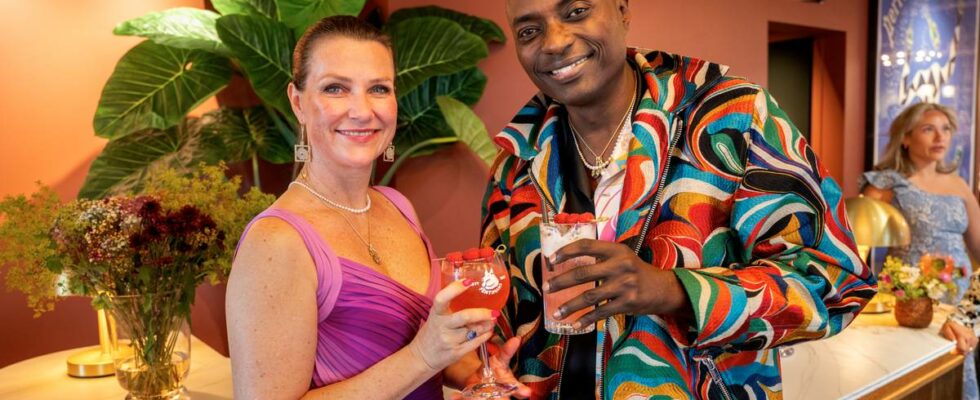The Directorate of Health believes that Oslo Håndverksdestilleri (OHD), which has made the so-called wedding gin “OHD Pink Gin”, has broken the law on several points. The directorate has concluded that both the ban on advertising for alcohol has been breached, and the ban on distributing alcohol for marketing purposes. When Durek Verrett took a walk in the streets of Ålesund this morning, it was only a few hours until he and Princess Märtha Louise began their wedding celebrations with a party at Hotel 1904. Durek Verrett met both locals, tourists, friends and press in the streets of Ålesund today . Photo: Mia Sofie Ytreberg / news When news asked the groom-to-be if the couple will serve gin at the party tonight, he was tight-lipped. – I don’t drink alcohol, said Verrett. But some of the guests might get a pink drink in the glass. In June, Princess Märtha Louise and Durek Verrett launched a “Pink Gin” specially made in connection with their wedding. Specially made gin for the wedding The gin, which is made by Oslo Håndverksdestilleri (OHD), was sold at Vinmonopolet. Princess Märtha Louise has said that it was her idea to make her own gin for the wedding, and that both she and Verrett have been very involved in the process. – We wanted a drink so that more people could taste what we serve at the wedding, the princess told VG at the launch. Both the label on the bottle and the manufacturer’s website stated that the gin was made for the wedding of the princess and Verrett, and their name and monogram adorned the label. It quickly provoked reactions. Princess Märtha Louise has an agreement with the king and the royal house that she will not use the title of princess in commercial activities. – A miss, said the princess’s manager and promised that the title would be removed from future bottles. Photo: Tom Balgaard / news Supervisory case opened The same week as the gin was launched, it also became clear that the Norwegian Directorate of Health opened a supervisory case to investigate whether the controversial princess gin violates the ban on alcohol advertising. The background was a notice on the alcovet organization Av-og-til. The organization asked the Directorate of Health to assess both whether the launch was against the law, and whether celebrities’ brands can be used to promote alcohol in this way. Ragnhild Kaski in Av-og-til reacted to the princess and Durek Verrett’s wedding gin and asked the Directorate of Health to look into the matter. Photo: Thomas Brun / NTB Kommunikasjon – Famous people have to internalize the influence they have, said general secretary Ragnhild Kaski to news. – We think it’s a shame that the princess and Durek Verrett choose to let their wedding, which will be a much-discussed media event, become an advertising poster for alcohol. In the notice that Kaski has sent to the Norwegian Directorate of Health, she asks the Directorate to assess the legality of: Whether the product itself violates the advertising ban, through the collaboration with Märtha Louise and Durek Verrett and the design of the product. If the invitation was sent to selected media for the launch of the product, it breaks the advertising ban. About Durek Verrett’s social media post about the product breaking the advertising ban. This means the ban on alcohol advertising According to the Alcohol Act, advertising for alcoholic beverages is prohibited. The Norwegian Directorate of Health says this about the law: “The term “advertising” is interpreted broadly and includes any form of mass communication for marketing purposes, cf. the alcohol regulations § 14-2. This includes, among other things, prohibitions on: Advertising for alcoholic beverages Advertising for goods with the same brand or characteristics as alcoholic beverages Allowing alcoholic beverages to be included in the marketing of other goods Editorial mention of alcohol falls outside the advertising ban, as long as the mention is not initiated, influenced or financed by industry players. Statements from private individuals are also not affected by the advertising ban, unless they appear to be initiated by or in favor of the alcohol industry. Influencers who showcase alcohol products may be in breach of the advertising ban if the content is designed, initiated, influenced or financed by industry players.” In the answers from the producer, Princess Märtha Louise and Durek Verrett to the Directorate of Health, it has emerged that the princess had several meetings with the producer. Durek Verrett was then in the USA and from there was very interested and involved in the process. He had a particular point of view on the design of the bottle and how it should look. – We found it natural that the monogram should adorn the bottle, said the reply from the couple to the Directorate of Health. It also emerged that during March the couple and the producer had several meetings about how the gin should be launched and sold. Had to change the label The bride and groom’s monogram adorned the gin bottle. Photo: Ann-Iren Finstad / news Vinmonopolet has previously temporarily stopped the sale of the gin, because it could be in breach of the alcohol advertising ban. Vinmonopolet concluded that the label on which Märtha Louise and Durek Verrett’s monogram was printed was in violation of the Advertising Prohibition Act. In order for the bottles to return to Vinmonopolet’s store shelves, a piece of black tape was pasted over the monogram on the labels. Princess Märtha Louise has made it clear that the couple has no financial gain from the sale of the wedding gin. Published 29/08/2024, at 2:30 p.m
ttn-69
Princess-gin broke the law – news Norway – Overview of news from different parts of the country

